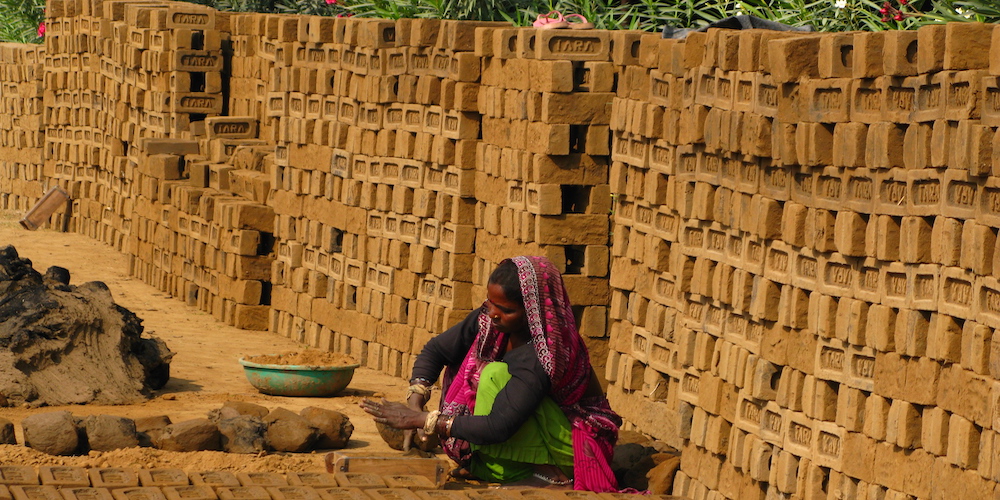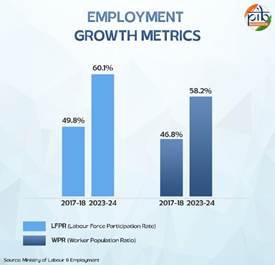Rising Workforce

As per the Ministry of Labour & Employment, crore in 2023-24 compared to 47.5 crore in 2017-18: a net addition of 16.83 crore jobs over six years, reflecting the government’s focus on youth-centric policies and its Viksit Bharat vision, says a government publication
The growth in the employment, going by the government data, is growth is specially significant because from an economic standpoint, Gross Domestic Product (GDP) alone cannot fully capture a nation’s true development. A more accurate picture emerges when multiple macroeconomic indicators are considered- with employment being one of the most critical. Employment carries both economic and social weight: higher job levels signal a stronger economy, stimulate consumption, and fuel sustained growth. For development to be meaningful, economic expansion must translate into the creation of productive, well-paying jobs that enhance livelihoods and social stability.
The Indian government measures employment regularly to track workforce trends, guide policymaking, and address job market challenges. To achieve this, the National Statistics Office launched the Periodic Labour Force Survey (PLFS), which provides timely estimates of key indicators like the Labour Force Participation Rate (LFPR), Worker Population Ratio (WPR), and Unemployment Rate (UR).
According to the recent PLFS, August 2025 monthly estimates were based on data collected from 3.77 lakh individuals – with 2.16 lakh surveyed in rural areas and 1.61 lakh in urban areas. At the all-India level, both key indicators of employment showed improvement between June and August 2025: LFPR – which measures the share of people aged 15+ who are working or seeking work – rose from 54.2% in June to 55% in August 2025. WPR – which reflects the share of employed persons in the population, also increased from 51.2% in June to 52.2% in August 2025.
The rise in WPR was observed in both rural and urban areas, contributing to the overall national improvement. Together, these trends highlight a healthier and more active labour market. On a broader level, LFPR for individuals aged 15 years and above rose from 49.8% in 2017–18 to 60.1% in 2023–24 and WPR increased from 46.8% to 58.2%.
Looking at sectoral trends, in the April-June 2025 quarter, the agriculture sector engaged the majority of rural workers (44.6% of men and 70.9% of women), while the tertiary sector was the largest source of employment in urban areas (60.6% of men and 64.9% of women). On average, 56.4 crore persons (aged 15 years and above) were employed in the country during this quarter, of which 39.7 crore were men and 16.7 crore were women.

Formal employment on the rise
In 2024–25, over 1.29 crore net subscribers were added to the Employees’ Provident Fund Organisation (EPFO), up from 61.12 lakh in 2018–19. Since the launch of the tracking system in September 2017, over 7.73 crore net subscribers have joined, including 21.04 lakh in July 2025 alone, indicating growing formalisation and enhanced social security coverage. 9.79 lakh new subscribers were added in July 2025 (60% in the 18-25 age group alone), owing to growing employment opportunities, increased awareness of employee benefits, and EPFO’s successful outreach programs.
Besides, there has been a clear shift in employment patterns – self-employment rose from 52.2% in 2017-18 to 58.4% in 2023-24, while casual labour fell from 24.9% to 19.8%, indicating a move toward entrepreneurial and independent work, supported by government initiatives.
Increase in wages of casual labourers & salaried workers
The average daily wage for casual labourers (excluding public works) rose from ₹294 in July–September 2017 to ₹433 in April–June 2024. Similarly, average monthly earnings of regular salaried workers increased from ₹16,538 to ₹21,103 over the same period. These gains point to higher income levels, improved job stability, and enhanced job quality.
Unemployment
Another positive sign has been the impressive decline in the UR, that dipped sharply from 6.0% in 2017–18 to 3.2% in 2023–24. This indicates stronger workforce absorption into productive employment. In the same time frame, youth unemployment rate declined from 17.8% to 10.2%, placingit below the global average of 13.3%, as reported in the ILO’s World Employment and Social Outlook 2024.
Unemployment among men (15+ years) fell to 5% in August 2025, the lowest since April. This drop was driven by a decline in urban male unemployment from 6.6% in July to 5.9% in August, while rural male unemployment eased to 4.5%- the lowest in four months. Overall, the rural unemployment rate has declined steadily for three consecutive months, from 5.1% in May to 4.3% in August 2025.
From Margins to Mainstream: Women Leading Workforce
One of the key pillars for achieving the vision of Viksit Bharat by 2047 is ensuring 70% women workforce participation in India. Today, major global institutions are praising India, as it paves its way up in the list of top countries with the highest equality. Women employment rate nearly doubled between 2017-18 to 2023-24. Data fromThe Ministry of Labour and Employment states that female LFPR increased from 23.3% in 2017-18 to 41.7% in 2023-24.
WPR for women aged 15 years and above rose from 22% in 2017-18 to 40.3% in 2023-24, LFPR increased from 23.3% to 41.7%.
More recently, Female WPR rose to 32.0% in August 2025 from 31.6% in July 2025 and 30.2% in June 2025 and Female LFPR increased to 33.7% in August 2025 from 33.3% in July 2025 and 32.0% in June 2025.
Besides, latest EPFO payroll data highlights a growing trend of formal employment among women. During 2024–25, 26.9 lakh net female subscribers were added to EPFO. In July 2025, ~2.80 lakh new female subscribers joined and the net female payroll addition stood at ~4.42 lakh, asserting today’s more inclusive and diverse workforce.
Key Dynamics Behind Employment Growth
At present, India is witnessing the rapid emergence of new industries and employment domains, driven by technological innovation, globalization, and evolving consumer behaviour.
• Sectors such as healthcare technology, e-commerce logistics, financial technology, and ed-tech are growing at an unprecedented pace.
o These industries are not only reshaping the nature of work but also generating new and diverse employment opportunities, particularly for the youth and digitally skilled workers.
• Growing digital economy and renewal energy sector are providing enhanced opportunities for job creation.
o Both these sectors offer immense potential to increase employment, especially opening opportunities for the women and thereby leading to their financial independence and empowerment.
Gig Economy
A defining feature of India’s evolving job market is the rise of gig economy, which has redefined traditional employment norms. With the spread of digital platforms offering freelance and project-based work, a growing number of Indians, especially millennials and Gen Z, are opting for flexible, non-traditional work arrangements in areas such as content creation, graphic design, marketing, software development, and consulting.
• India’s gig workforce is estimated to grow from 1 crore in 2024–25 to 2.35 crore by 2029–30.
• Through measures such as the Code on Social Security (2020) and the e-Shram portal, the government is actively working to recognise, safeguard, and empower gig and platform workers. As of 30 September 2025, more than 31.20 crore workers have registered, suggesting a broader global trend toward flexible work, work-life balance, and digital livelihoods.

Startups and Global Capability Centres (GCCs)
India’s demographic dividend is being actively cultivated through targeted initiatives, which aim to bridge the gap between education and employment. The economy is also witnessing job growth in emerging sectors such as startups and global capability centres (GCCs), creating new and diverse employment opportunities for the youth. India’s startup ecosystem boasts 1.9 lakh DPIIT-recognized startups- the world’s 3rd largest, creating over 17 lakh jobs and 118 unicorns as of 2025.
Below are some interesting facts which give a clear understanding of the sectoral growth of India’s employment landscape.
Key Government Initiatives Strengthening India’s Employment
By creating a skilling ecosystem with a high-quality, globally competitive workforce, India can enhance employability for youth in global job markets. The government’s persistent efforts through diverse initiatives have led to higher workforce participation, reduced unemployment, improved incomes, and broader opportunities spanning traditional as well as new-age sectors.
Skill India
Under the Skill India Mission, the Ministry of Skill Development and Entrepreneurship (MSDE) provides skill, re-skill, and up-skill training through a nationwide network of centres. Key schemes include the following;
Rozgar Mela
The government has been organizing Rozgar Melas to boost employment initiatives in the country through the National Skill Development Corporation (NSDC), under the Ministry of Skill Development & Entrepreneurship (MSDE). These events aim to connect unemployed youth with suitable job opportunities in the private sector. It is a half-day event where employers and job seekers gather to apply for and interview for job positions. Notably, over 11 lakh aspirants got jobs in the last 16 months under the Rozgar Mela.
PM Vishwakarma
This scheme aims to provide holistic support to artisans and craftspeople in scaling up their conventional products and services. As on 30 September 2025, there were ~30 lakhs registered artisans and craftsmen, with skill verification completed for 26 Lakhs+ beneficiaries.
ITI upgradation Scheme
Approved in May 2025, the scheme envisages upgradation of 1000 Govt. ITIs in a hub and spoke model as state-led, industry-managed skilling institutions. 200 ITIs will function as hub institutions and 800 as spokes. Besides, 20 lakh youth are aimed to be skilled over a five year period.
The Employment Linked Incentive (ELI) Scheme
It seeks to support job creation, enhance employability, and expand social security coverage, with focus on manufacturing sector. It aims to create 3.5 crore+jobs in two years with an outlay of ₹1 lakh crore.
Mahatma Gandhi National Rural Employment Guarantee Act (MGNREGA)
It aims to enhance livelihood security by providing at least 100 days of guaranteed wage employment to rural households whose adult members are willing to undertake unskilled manual work. Rs 86,000 crore has been allocated for MGNREGA in FY 2025–26, the highest since the scheme’s inception in 2005.
Additionally, for creating industry-ready workforce, initiatives like internships in companies (PM Internship Scheme) and public-private partnership for skill development and vocational training are poised to go a long way. Besides, the Make In India initiative seeks to revitalize manufacturing, generate large-scale employment especially for semi-skilled and unskilled workers.
Initiatives Specifically for Women
Specific initiatives aim to empower women through skills, employment, and entrepreneurship. Below mentioned are some of the key government initiatives that are strenthening Indian women employment landscape, resulting inwomen’s economic empowerment.
• Namo Drone Didi: A central sector scheme, it aims to empower women-led Self-Help Groups (SHGs) by equipping them with drone technology to provide agricultural services. The scheme aims to provide 15, 000drones to selected Women SHGs (2024-25 to 2025-2026) for providing rental services to farmers for agriculture purpose (application of liquid fertilizers and pesticides for the present). This initiative is likely to generate an additional income of at least Rs. 1 lakh per year for each SHG, contributing to economic empowerment, sustainable livelihood generation.
• Mission Shakti: By promoting awareness, creating a secure environment, and offering workshops and training, Mission Shakti seeks to transform women’s lives and foster an inclusive and empowered society. The Ministry of Women and Child Development is also implementing the ‘Palna’ component under Mission Shakti, aimed at providing daycare services and child protection.
• Lakhpati Didi Scheme: A Lakhpati Didi is a SHG member with an annual household income of ₹1,00,000 or more. This income is calculated for at least four agricultural seasons and/or business cycles, with an average monthly income exceeding ₹10,000, so that it is sustainable. India aims to create 3 crore Lakhpati Didis, and 2 crore women have already achieved this milestone.
Besides, various other schemes like Bank Sakhi, Bima Sakhi, Krishi Sakhi, and Pashu Sakhi have enabled women to find sustainable employment. To garner women entrepreneurship, the government has launched several initiatives in terms of easier access tocredit, marketing support, skill development, support to women start-ups, etc. Schemes and initiatives such as the PM Employment Guarantee Programme, SANKALP, PM Micro Food Processing Scheme, Adivasi Mahila Sashaktikaran Yojana, Swayam Shakti Sahakar Yojna, DAY-NRLM, and others are fostering women-led enterprises by providing financial assistance, skill training, and mentorship. These measures are empowering women entrepreneurs to launch and expand their businesses.
To further enhance women’s participation in the workforce, the government is implementing several programmes like Women in Science and Engineering (WISE-KIRAN) and SERB-POWER, which promote women in research and development.


